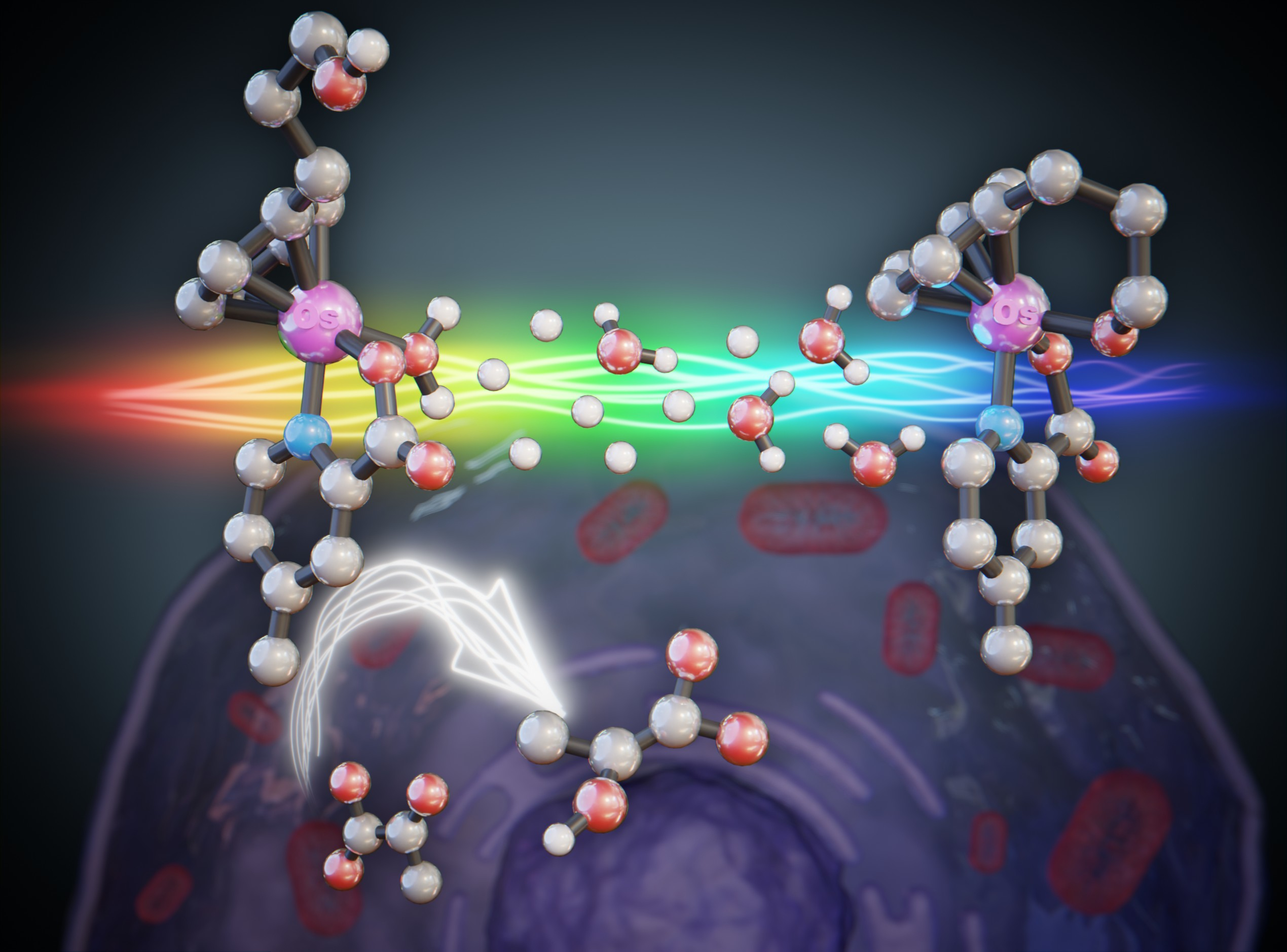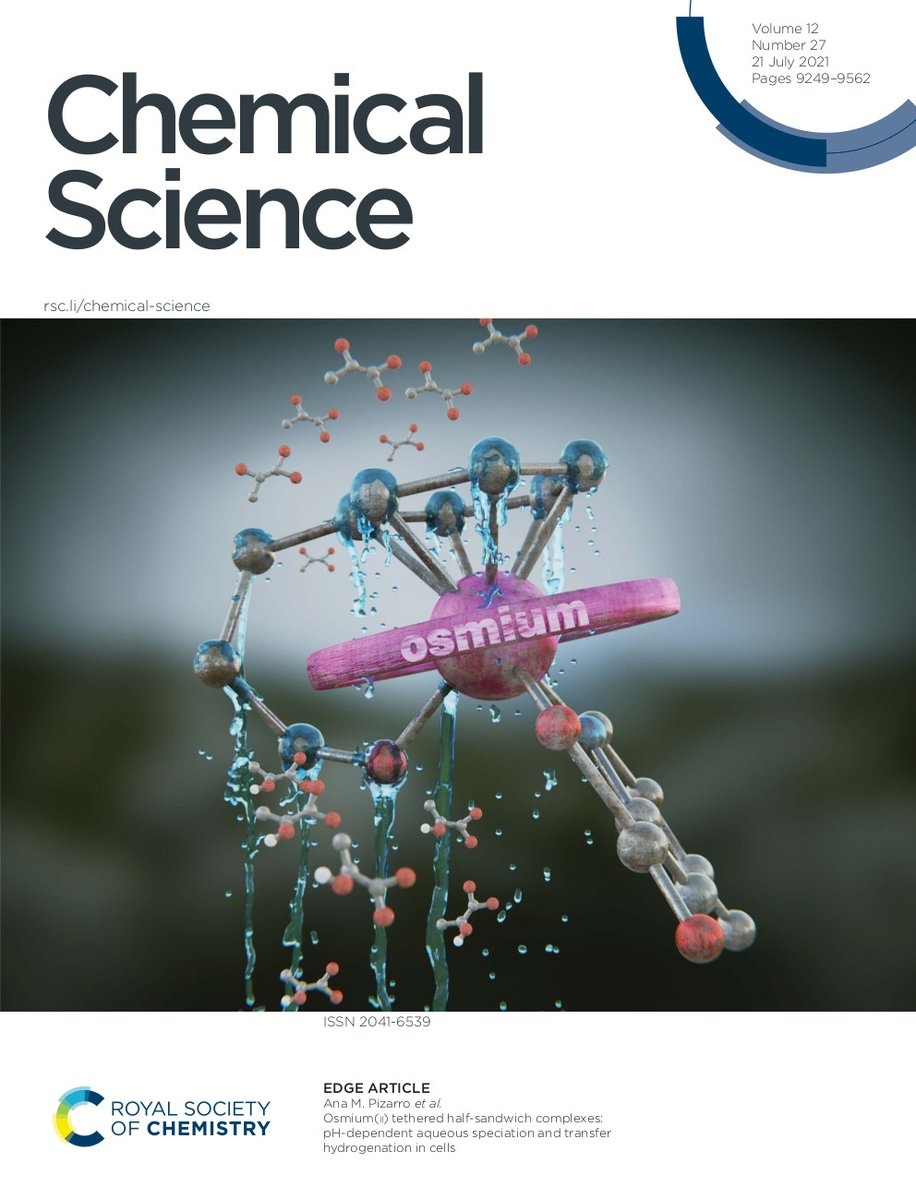Osmium activation in cancer cells
30.06.2021
 |
|
A new family of osmium compounds with chemical reactivity inside the cancer cell is presented. Aquation promotes reversible tether-ring formation as a “swinging-gate”, stopping the formation of inert osmium species. Strikingly, these complexes mediate hydrogenation of pyruvate to lactate inside cancer cells. Imagen: Scixel. |
- Researchers at the Metallodrugs Group at IMDEA Nanociencia have shown the unprecedented reactivation of an osmium compound within a family believed to be inert in cells.
- The osmium compounds carry out transfer hydrogenation reactions inside cancerous human cells.
- The research, published in Chemical Science, has been chosen as Pick of the Week by editors.
Madrid, 30th June, 2021. Cancer is a complex disease, and as such, there is not just a single way to tackle it. While cancer treatments are evolving towards personalised procedures, in most cases standard chemotherapy treatments are still required. In chemotherapy, platinum drugs such as cisplatin (approved 42 years ago by FDA) are used, killing both cancerous and healthy cells and causing unwanted sided effects. In this regard, there is plenty of room for improvement for clinical treatments.
New complexes based on organometallic compounds are currently under investigation to see how they can be activated (light, pH) and specifically intervene only in cancer cell processes (for example, affecting cancer cell metabolism).
The Metallodrugs Group at IMDEA Nanociencia, led by Dr Ana Pizarro, focuses on exploiting the peculiar nature of transition metals and the unique types of chemical interactions that these metals can carry out inside the cell. This uniqueness of metal-based drugs, in combination with current knowledge in molecular biology, allows for the development of new compounds for more specific and targeted chemotherapies as a natural step forward.
In their recent Chemical Science publication, Pizarro and co-workers study the possibilities of osmium (Os) to modify the cancer cell machinery. These compounds are largely unexplored due to their apparent inertness. The group saw an opportunity to exploit this inertness in order to control their reactivity in the cell. They discovered the unprecedented reactivation of an osmium compound in aqueous solution by introducing in the structure a pendant terminal alcohol that furnishes the complex with an entirely new reactivity profile.
Osmium arenes often generate inactive species due to the acidity of the metal. The Os-OH triggers intramolecular rearrangement culminating in the binding of the pendant oxygen to the metal centre (formation of a closed tethered complex) thus protecting the complex towards irreversible inactivation –the otherwise unreactive osmium species reactivates thanks to the tethered alcohol.
“Transition metals in general can be promiscuous: they try to catch every atom around them. We thought we could exploit the inherent inertness of osmium to fine-tune its metal-based reactivity”, Dr Pizarro comments. “If we are to create useful tools to manipulate the cancer cell we must take advantage of this fine balance between metal-reactivity and inertness, unique to organometallics.”
The activity of osmium compounds was tested within breast cancer cells in vitro. It was found that these compounds help convert pyruvate to lactate, both of which are essential metabolites in the intricate metabolism of the cancerous cell.
This fundamental research adds to the knowledge of organometallic compounds modulating cell machinery towards fighting cancer. The Pizarro group have demonstrated that the osmium compounds can be candidates for modulating the lactate/pyruvate balance within human cells, a crucial aspect of cancer progression.
This research has been partially funded by the EU 7th Framework Programme through the MEMOTUMCELLMACH project and the Severo Ochoa Centre of Excellence Award to IMDEA Nanociencia (2017-2021). This research is published in Chemical Science, the Royal Society of Chemistry’s peer-reviewed flagship journal, and is free to read here. The publication has been chosen Pick of the Week by editors of Chemical Science, and is the front cover of the number 12(27).
Referencia:
S. Infante-Tadeo, V. Rodríguez-Fanjul, A. Habtemariam, A. M. Pizarro. Osmium(II) tethered half-sandwich complexes: pH-dependent aqueous speciation and transfer hydrogenation in cells. Chem. Sci. 2021,12, 9287-9297. DOI: 10.1039/D1SC01939B
This article was featured as Pick of the Week and included in the Hot Paper Collection of Chemical Science 2021. It was also selected to be featured in the front outside cover of issue 27. See an animated version of this cover in this link.
Contact
Dr. Ana M. Pizarro
ana.pizarro [at]imdea.org
http://nanociencia.imdea.org/home-en/people/item/ana-maria-pizarro-arranz
Twitter: @pizarroam
IMDEA Nanociencia - Outreach Office
divulgacion.nanociencia [at]imdea.org
Twitter: @imdea_nano
Facebook: @imdeananociencia
Instagram: @imdeananociencia
Source: IMDEA Nanociencia





